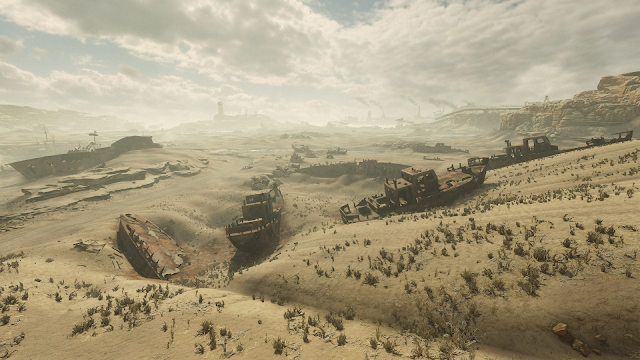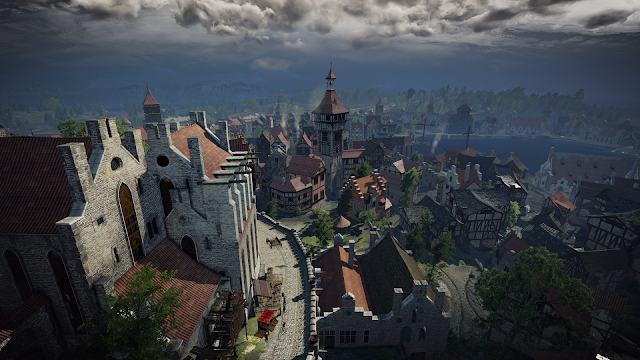Broken Landscapes
Walk around the Russian wilderness in Metro Exodus for long enough and you’ll pick up on something strange: the landscapes are all in a certain sense broken.
There are some segments in Moscow, Yamantau, and a place known as the Dead City, but Metro Exodus basically has three different areas to explore. These are the Volga, Caspian Sea, and Taiga regions. Relative to their counterparts in the real world, they’re all represented in the game as being warped in some way, shape, or form. Flowing through central Russia, the Volga River for example is actually surrounded by rolling hills, flat farmland, and plenty of forest, but you’ll find only muddy marshes in Metro Exodus. The expansive Caspian Sea has apparently dried up. The totally firm Taiga seems to have been torn apart by shifting tectonics. Regardless of which region you explore in the game, you’ll be looking at what amounts to a broken landscape.
What meaning is there behind these broken landscapes? The game is clearly commenting on how easily we can ruin the world around us. There are multiple dimensions to this commentary. While it definitely warns against nuclear war, Metro Exodus could also be seen as cautioning us about climate change.
Searching for a safe haven after nuclear war turns the world into a wasteland, you spend quite a bit of your time in Metro Exodus aboard a train called the Aurora. The machine is almost constantly in motion, but whenever it comes to a standstill, you get to step out and stretch your legs. When it winds up needing repairs, the first place where it stops to let you blow off some steam is the Volga region.
While the embankment under the railroad seems pretty solid, every other part of the Volga region is apparently sinking. Take a few minutes to get your bearings after leaving the Aurora and you’ll notice that you’re completely surrounded by muck and mud. Stretching as far as the eye can see, the bog is pretty much endless by the look of things, but it’s definitely not supposed to be uninhabited. There’s a tiny town with a church to the southwest and an oil refinery to the northeast of your starting point. You’ll need to find yourself a boat before you can explore either one of these places, though. There’s a good reason for this. While the church has apparently been set up on stilts, the town itself is almost totally submerged. The oil refinery sits a few feet underwater, too.
You’ll be riding the rails for a while after you repair the Aurora, but you’ll soon find yourself searching for some satellite imagery inside a bunker on the banks of the Caspian Sea.
You’d never suspect that anyone could possibly survive in the Caspian Sea region. While there’s a bit of water, the shoreline seems to have receded, so the place looks pretty parched. When you’re not blinded by a sandstorm, you’ll see almost nothing but shimmering dunes in every direction. You’re hardly alone in this desert wasteland, though. Raiders can be found terrorizing the region with a fleet of cars, trucks, and vans. Refining the oil which oozes up to the surface, they’ve apparently set up shop in a drilling platform to the northeast of your starting point. Suggesting dramatic levels of desertification, this drilling platform is clearly of the offshore variety, but now sits high and dry above the bare bottom of what was once the Caspian Sea. The surrounding landscape is littered with dozens of beached boats.
You’ll be back on the tracks after finding your satellite imagery. The next place where the Aurora grinds to a halt is the Taiga region.
With its green trees and blue water, the Taiga region looks like paradise at first blush, but closer inspection reveals a few red flags. These make it appear a lot more like purgatory. While some of them seem to be living in caves, most of the inhabitants can be found in makeshift camps to the north of your starting position. They’re clearly supposed to have fled the formerly settled areas. Explore almost any of the abandoned buildings in the region and you’ll soon realize the reason for this. Pulling apart the landscape, a series of quakes, shocks, and tremors have created cracks which cut right through them, causing buildings to collapse into what seem like bottomless chasms. You’ll come across gaping holes and deep ditches throughout the region. Several of these are filled with rusty cars.
Relative to their counterparts in the real world, the landscapes in Metro Exodus are all warped in some way, shape, or form. Why are they depicted like this? The answer mostly has to do with our relationship to the environment.
The world is bigger than any of us, but it’s a bit more fragile than you’d think. Showing how easily we can destroy the planet, Metro Exodus definitely warns against nuclear war, but the game also cautions about climate change. Tearing apart the Taiga, drying up the Caspian Sea, and filling the Volga with muddy marshes, Metro Exodus provides a reminder that we’re more than capable of ruining the world around us. Taking place after a nuclear apocalypse, the game argues that we’ll probably figure out some way to cope with the consequences of our actions, but that we might just have to make do with broken landscapes. The real question though is why anyone should have to accept such an outcome. We can avoid nuclear war. We can stop climate change, too.
There are some segments in Moscow, Yamantau, and a place known as the Dead City, but Metro Exodus basically has three different areas to explore. These are the Volga, Caspian Sea, and Taiga regions. Relative to their counterparts in the real world, they’re all represented in the game as being warped in some way, shape, or form. Flowing through central Russia, the Volga River for example is actually surrounded by rolling hills, flat farmland, and plenty of forest, but you’ll find only muddy marshes in Metro Exodus. The expansive Caspian Sea has apparently dried up. The totally firm Taiga seems to have been torn apart by shifting tectonics. Regardless of which region you explore in the game, you’ll be looking at what amounts to a broken landscape.
What meaning is there behind these broken landscapes? The game is clearly commenting on how easily we can ruin the world around us. There are multiple dimensions to this commentary. While it definitely warns against nuclear war, Metro Exodus could also be seen as cautioning us about climate change.
 |
| The landscapes are all in a certain sense broken |
Searching for a safe haven after nuclear war turns the world into a wasteland, you spend quite a bit of your time in Metro Exodus aboard a train called the Aurora. The machine is almost constantly in motion, but whenever it comes to a standstill, you get to step out and stretch your legs. When it winds up needing repairs, the first place where it stops to let you blow off some steam is the Volga region.
 |
| The Volga seems to be sinking |
While the embankment under the railroad seems pretty solid, every other part of the Volga region is apparently sinking. Take a few minutes to get your bearings after leaving the Aurora and you’ll notice that you’re completely surrounded by muck and mud. Stretching as far as the eye can see, the bog is pretty much endless by the look of things, but it’s definitely not supposed to be uninhabited. There’s a tiny town with a church to the southwest and an oil refinery to the northeast of your starting point. You’ll need to find yourself a boat before you can explore either one of these places, though. There’s a good reason for this. While the church has apparently been set up on stilts, the town itself is almost totally submerged. The oil refinery sits a few feet underwater, too.
You’ll be riding the rails for a while after you repair the Aurora, but you’ll soon find yourself searching for some satellite imagery inside a bunker on the banks of the Caspian Sea.
 |
| The Caspian Sea has apparently died up |
You’d never suspect that anyone could possibly survive in the Caspian Sea region. While there’s a bit of water, the shoreline seems to have receded, so the place looks pretty parched. When you’re not blinded by a sandstorm, you’ll see almost nothing but shimmering dunes in every direction. You’re hardly alone in this desert wasteland, though. Raiders can be found terrorizing the region with a fleet of cars, trucks, and vans. Refining the oil which oozes up to the surface, they’ve apparently set up shop in a drilling platform to the northeast of your starting point. Suggesting dramatic levels of desertification, this drilling platform is clearly of the offshore variety, but now sits high and dry above the bare bottom of what was once the Caspian Sea. The surrounding landscape is littered with dozens of beached boats.
You’ll be back on the tracks after finding your satellite imagery. The next place where the Aurora grinds to a halt is the Taiga region.
 |
| The Taiga seems to have been torn apart by shifting tectonics |
With its green trees and blue water, the Taiga region looks like paradise at first blush, but closer inspection reveals a few red flags. These make it appear a lot more like purgatory. While some of them seem to be living in caves, most of the inhabitants can be found in makeshift camps to the north of your starting position. They’re clearly supposed to have fled the formerly settled areas. Explore almost any of the abandoned buildings in the region and you’ll soon realize the reason for this. Pulling apart the landscape, a series of quakes, shocks, and tremors have created cracks which cut right through them, causing buildings to collapse into what seem like bottomless chasms. You’ll come across gaping holes and deep ditches throughout the region. Several of these are filled with rusty cars.
Relative to their counterparts in the real world, the landscapes in Metro Exodus are all warped in some way, shape, or form. Why are they depicted like this? The answer mostly has to do with our relationship to the environment.
The world is bigger than any of us, but it’s a bit more fragile than you’d think. Showing how easily we can destroy the planet, Metro Exodus definitely warns against nuclear war, but the game also cautions about climate change. Tearing apart the Taiga, drying up the Caspian Sea, and filling the Volga with muddy marshes, Metro Exodus provides a reminder that we’re more than capable of ruining the world around us. Taking place after a nuclear apocalypse, the game argues that we’ll probably figure out some way to cope with the consequences of our actions, but that we might just have to make do with broken landscapes. The real question though is why anyone should have to accept such an outcome. We can avoid nuclear war. We can stop climate change, too.



